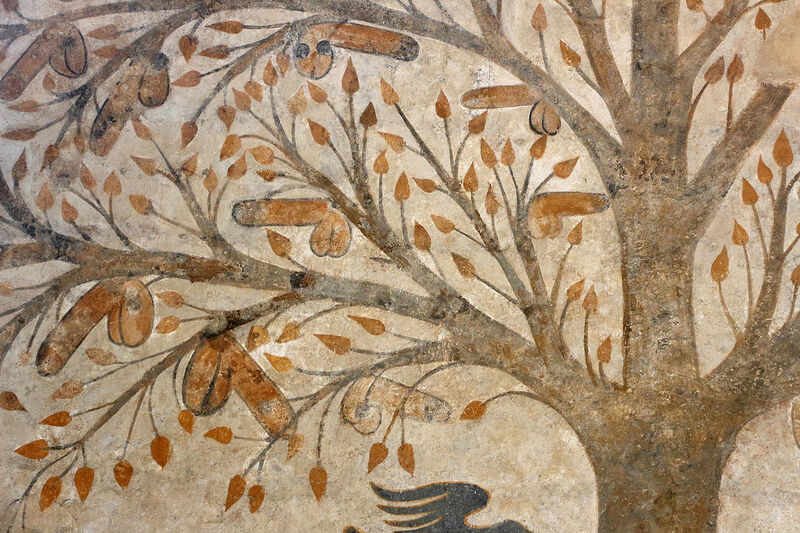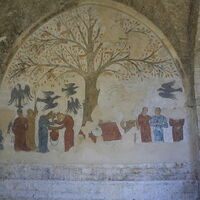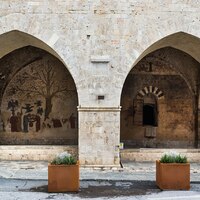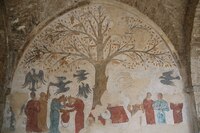Penis tree
Date:
1265,
early fourteenth century
Location or Findspot (Modern-Day Country):
Italy
Description:
In the thirteenth century the town of Massa Marittima (Italy) enjoyed a building boom, with a new urban center consisting of a rebuilt cathedral, town hall, market, residence of the local ruler (podestà), and several large houses. Also in this new "downtown" was a large fountain, placed within an arched shelter or loggia and completed in 1265. Having a supply of fresh running water at the center of a hill town was unusual for this time and place; people living in nearby Siena, for instance, collected water from fountains located on lower terrain outside the city walls and then carried it back up the hill to their homes. In the fourteenth century, a grain hall was built on top of the loggia and a granary (storage area for grain) to the side. This kind of building, combining spaces for commerce (an "exchange") and the storage of goods, was increasingly common in the late Middle Ages, an era of commercial and urban expansion. The complex in Massa Marittima came to be known as the Palace and Fountain of Abundance (Palazzo e Fontana dell’Abbondanza). The fountain remained in use until the early twentieth century.
Restoration of the interior walls of the loggia in 2000 removed layers of plaster, paint, and mineral deposits. In one bay the work uncovered a wall painting likely dating to the first decades of the fourteenth century. Although repainted in places (particularly along the lower half, which was closest to the water and its damaging dampness), the wall features a large deciduous tree and women arrayed around it, picking its "fruits"—penises. While the women on the right side of the tree seem friendly and harmonious, those on the left are agitated, with two pulling each other’s hair as they fight over a penis in a basket. Another woman uses a tool to reach toward the tree, while one looks down at a penis that seems to be aimed at or penetrating her buttocks. Huge black birds fly close to the women; they are eagles, symbols of the Ghibellines, the imperial political party that ruled Massa at various points in the thirteenth and fourteenth centuries. The bird with sharp talons about to alight on the sodomized woman’s head resembles the imperial coat of arms: it faces forward, with both wings outstretched and head in profile. Here, then, the birds are menacing anti-Ghibelline references. They indicate that the painting dates from the early fourteenth century, when the Guelfs, the papal party opposed to the Ghibellines, ruled Massa. This painting may have been accompanied by others representing good government, such as those found in the Palazzo Pubblico in Siena.
Not all of the painting’s meanings are well understood. Ancient Roman fountains often bore phallic motifs, underlining connections between water, bodily effluvia, and regeneration; in the loggia at Massa, that idea was underscored not only by the painting but also by carved capitals that feature male and female genitalia. One theory links the painting to descriptions of witchcraft that circulated in later centuries. In one of the most famous anti-magic diatribes, the Malleus Maleficarum (Hammer of Witches), witches were portrayed as collecting male genitals and placing them in trees, where they developed a "life" of their own. Penis-tree imagery appeared in various places in western Europe in the late Middle Ages, and it may be that the pictures inspired such stories and fueled anxieties about witches, witchcraft, male impotence, and sodomy.
Restoration of the interior walls of the loggia in 2000 removed layers of plaster, paint, and mineral deposits. In one bay the work uncovered a wall painting likely dating to the first decades of the fourteenth century. Although repainted in places (particularly along the lower half, which was closest to the water and its damaging dampness), the wall features a large deciduous tree and women arrayed around it, picking its "fruits"—penises. While the women on the right side of the tree seem friendly and harmonious, those on the left are agitated, with two pulling each other’s hair as they fight over a penis in a basket. Another woman uses a tool to reach toward the tree, while one looks down at a penis that seems to be aimed at or penetrating her buttocks. Huge black birds fly close to the women; they are eagles, symbols of the Ghibellines, the imperial political party that ruled Massa at various points in the thirteenth and fourteenth centuries. The bird with sharp talons about to alight on the sodomized woman’s head resembles the imperial coat of arms: it faces forward, with both wings outstretched and head in profile. Here, then, the birds are menacing anti-Ghibelline references. They indicate that the painting dates from the early fourteenth century, when the Guelfs, the papal party opposed to the Ghibellines, ruled Massa. This painting may have been accompanied by others representing good government, such as those found in the Palazzo Pubblico in Siena.
Not all of the painting’s meanings are well understood. Ancient Roman fountains often bore phallic motifs, underlining connections between water, bodily effluvia, and regeneration; in the loggia at Massa, that idea was underscored not only by the painting but also by carved capitals that feature male and female genitalia. One theory links the painting to descriptions of witchcraft that circulated in later centuries. In one of the most famous anti-magic diatribes, the Malleus Maleficarum (Hammer of Witches), witches were portrayed as collecting male genitals and placing them in trees, where they developed a "life" of their own. Penis-tree imagery appeared in various places in western Europe in the late Middle Ages, and it may be that the pictures inspired such stories and fueled anxieties about witches, witchcraft, male impotence, and sodomy.
Relevant Textbook Chapter(s):
9
Image Credits:
Wikimedia Commons




